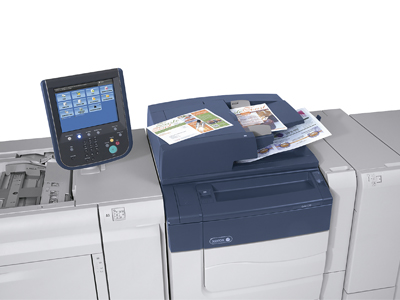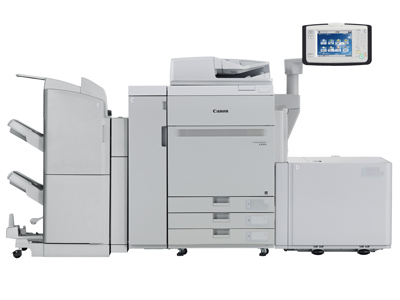Canon’s entry-level ImagePress C650 can produce 65ppm
There’s more to buying an entry-level printer than just looking for budget models, finds Nessan Cleary.
Digital printers come in all shapes and sizes these days, but if we look just at the entry-level document printers then there are quite a few options for anyone looking to get started. Anna Askels, European product marketing manager for Xerox, says that these printers are sold to a wide range of different customers such as copy shops and high street printers where cost and footprint are important, through to commercial printers wanting to do variable data or short runs and to shorten the turnaround times. She adds, ‘Then also [to] the creative agencies and designers, as well as offices, especially with security becoming more important and some are bringing print that they used to outsource back in-house and of course, CRDs.’
So these entry-level printers have to have the features necessary to satisfy many different needs, while at the same time keeping the cost relatively low. The result is that most vendors have borrowed some technology from their high volume machines, particularly media transport and imaging engines, but have cut costs in other areas.
Karl-Friedrich Edenhuizen, product manager for Konica Minolta’s Production Printing Group in Europe says that there is a lot of crossover between office machines and production ones: ‘We mainly see the difference as not so much in speed, maybe more in volume and finishing and definitely more in media support. A production printing machine must support coated papers. Production printing usually needs higher weights because one of the main applications is business cards.’ Note that for some printers, the productivity will fall off with the heavier media.

Karl-Friedrich Edenhuizen, product manager for Konica Minolta’s Production Printing Group in Europe
Mr Edenhuizen adds that commercial printers tend to need higher quality than CRD users and that it’s very important that the first sheet of a run matches the last. Production machines are also more likely to come with a digital front end (DFE), with just about every vendor offering an EFI Fiery option. Mr Edenhuizen points out, ‘Commercial printers and large CRDs will have a dedicated operator so the controller is of crucial importance but it doesn’t matter if you are just sending jobs by the network.’
What’s available?
Several manufacturers make office copiers but we’ve only included those where there are options to add a DFE and the kind of finishing that a commercial printer would need, such as punches, inserters and booklet makers. In most cases there’s also a clear upgrade path to higher volume printers, important if you grow this side of your business.
Not surprisingly, one of the major players in this segment is Xerox. Ms Askels says that the Xerox entry level printers benefit from technology developed for office use, such as security features, as well as production-class features like colour matching. She says that reliability is important, adding, ‘We want to make sure that all the components are customer-replaceable so that you can replace a drum or fuser yourself to keep your device up and running.’
Xerox sells the Colour C60/C70 printers, which are aimed at quick print shops and in-plant operations. They can handle a wide range of substrates from 60 up to 256gsm duplex, and 300gsm simplex, which is handy for things like cards or invitations. There’s a simple but effective level of automation through the Simple Image Quality Adjustment (SIQA) feature, which helps maintain registration and supports difficult jobs like double-sided business cards. There are also closed-loop process controls which should lead to higher quality printing with less operator involvement. There’s even a Paper Catalogue with an on-line library of substrate attributes.

Xerox Color C60/C70 prints on linen for applications like event planning, appliques and luxurious embellishments
There’s a choice of DFEs, including Xerox’s own FreeFlow Print Server with new production colour management tools. In addition, there’s an option for an EFI Fiery NX station complete with QuickTouch technology that enables the sort of high-end production colour management that’s normally found on more expensive devices.
Xerox also sells the Versant 180, which offers more automation, particularly in setting up the colour calibration. This runs at 80ppm and is good for an average monthly volume of up to 80,000 pages. The standard configuration can handle 52 to 220gsm substrates but this can optionally be extended to 350gsm. It can work with a wide range of coated and uncoated paper as well as greetings card, synthetic papers and window films.
Ms Askels says that there’s no one size fits all and it depends on the needs of individual customers. Commercial printers are more likely to choose the Versant models because of the greater automation but she adds, ‘I have seen cases where a C60 has been used as a proofer to a larger machine.’
Konica Minolta has several printers spanning the office and light production space. As a general rule, the company tends to reserve its latest toners for its high end production printers. Mr Edenhuizen says that this is because the imaging engines have different needs, noting, ‘In the office world the start-up time needs to be very short but in production printing we are printing all the time so this doesn’t matter.’
The AccurioPrint C2060L has been designed as an entry-level production printing machine, mainly aimed at CRDs. It has automatic density balance and can produce banners up to 1.2m long. It offers 1200 x 1200dpi at 8 bits and can produce 61 A4ppm. It takes media up to A3+ and 300gsm. There’s a range of finishing options including a booklet maker, inserter and punch kit. There’s a choice of front ends, including the inevitable Fiery.
Konica Minolta also sells the Bizhub Pro C754e, which is designed to handle a mix of colour and black and white work. It can produce 60 A4 colour pages per minute, or 75 black and white, with an 1800 x 600dpi resolution. It takes media from 52 to 256gsm for duplex printing, which can be increased to 300gsm simplex. It comes with an embedded Fiery controller.

Ricoh sells this Pro C5200 series digital colour presses for the light production segment
Ricoh announced a new set of light production printers earlier this year, the Pro C5200 series. These are aimed at commercial printers as well as print for pay operations and corporate repro departments. There are two models – the C5200s and C5210s – which run at print speeds of 65 and 80 pages per minute, with a maximum resolution of 1200 x 4800dpi. They take media up to 360gsm and can print long sheets up to 1260mm. Both printers can be loaded with up to 8250 sheets.
EFI has developed a Fiery front end for these presses too. There’s also an optional Booklet Finisher with saddle stitching and folding capabilities, as well as an optional Cover Interposer.
Canon sells two entry-level ImagePress printers, the C850 and the C650. The C850 can produce 85 A4ppm, which equates to a recommended monthly volume of around 150,000 pages. The C650 is a more compact unit with a running speed of 65ppm. It can handle up to 120,000 A4 pages per month. Both offer front to back registration tolerance of 1.0mm and 2400 x 2400dpi resolution with the standard 256 gradations. They take media up to SRA3 and 300gsm, including for duplex printing.
There are quite a number of finishing options available for these printers, which should make them an attractive option for some commercial printers. These include a two-knife booklet trimmer, a paper folding unit, a document insertion unit, a booklet finisher, a multi-hole punch including creasing and a staple finisher. There’s also a choice of RIPs, including Canon’s own PrismaSync and EFI’s Fiery as well as optional kits to integrate with office workflow systems.
Intec has built up a reputation for producing affordable digital presses that allow small print shops to get into personalised printing. Its current offering is the ColorSplash series, which are SRA3 model capable of printing up to 50 A4 pages per minute in colour or monochrome and 28ppm on A3. These are based on LED toner technology and print in CMYK at 1200 x 1200dpi.
The ColorSplash engines use a straight-through paper path that allows them to handle a wider range of substrates, including polyester, digital PE or light 55gsm NCR type media up to 500gsm heavy card stocks or less flexible substrates such as magnetic and metallic foil media. This also includes extended paper size formats from 63 x 89mm right up to 330 x 1321mm long for banner printing, useful for unusual formats such as A4 landscape, tri-fold or concertina style products.
They have a modular design that accepts a range of print production and finishing modules. This includes Intec’s feeders and finishers for applications such as banners, envelopes, labels and packaging. There’s also an optional Fiery XF RIP.
In conclusion, there’s no simple advice as to which type of entry-level printer to invest in. It all comes down to the needs of individual print houses. In general, the imaging quality is not an issue and all of these machines should handle a reasonable range of substrates. Instead, the main issues to look for are the ability to handle heavier papers at speed, and the level of control over the colour output. But the main issue by far is the front end, because digital printing is only really effective if you can push a lot of short run jobs to the print engine, which means having an effective workflow.
Read the full November issue of Digital Printer here. Subscribe to the magazine for free – register your details here.






